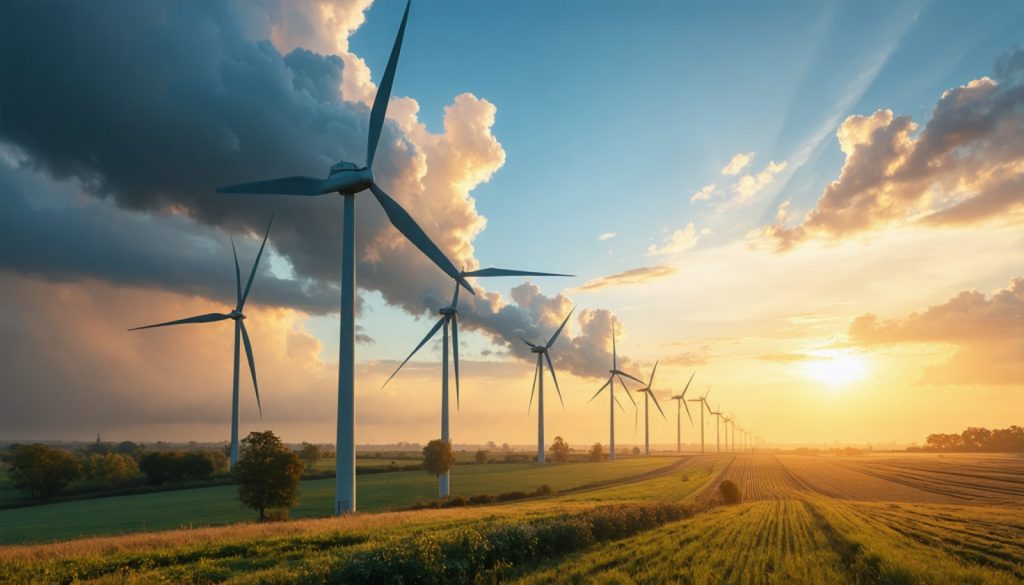
- The UK’s AI Energy Council is launched to align the nation’s clean energy goals with AI development, aiming for economic growth and sustainability.
- Co-chaired by the Technology and Energy Secretaries, the council focuses on integrating renewable energy and improving energy efficiencies within data centers.
- The strategy includes establishing AI Growth Zones leveraging existing energy grids, potentially providing power for two million homes.
- The initiative seeks to make the UK a prime destination for tech investment, creating job opportunities and boosting regional economies.
- Key players like EDF, Scottish Power, Google, and Microsoft collaborate to expedite grid connections for expansive AI projects.
- The council plans to position the UK as a leader in clean energy, driving sustainable economic growth with the quarterly meetings fostering ongoing progress.
Under the sprawling canopy of Whitehall, influential leaders from the realms of energy and technology converge today for a critical mission: to architect the future of the United Kingdom’s energy infrastructure in an era dominated by artificial intelligence. This gathering marks the maiden meeting of the UK’s newly minted AI Energy Council, a powerhouse assembly tasked with synchronizing two of the nation’s core ambitions—clean energy dominance and AI development—to create a robust economic renaissance.
As dawn breaks over the River Thames, the council, co-chaired by the Technology and Energy Secretaries, embarks on a relentless pursuit of clarity and action. Members will forge a roadmap that aligns the UK’s clean energy objectives with its AI aspirations, placing emphasis on sustainability and economic growth as unshakeable bedrocks of this national strategy. From the sprawling wind farms weaving across the Scottish landscapes to the nuclear fortresses dotting the country, clean energy will be harnessed to fuel this AI-driven leap forward.
Expectations are soaring that the council will chart paths toward a sustainable fusion of AI with the nation’s energy grid, focusing on integrating renewables and advancing energy efficiencies within data centers. Such ambition aims not just to satiate the colossal energy demands of AI infrastructures but to breathe life into local economies by fostering job growth and innovation.
A global leader in AI readiness, the UK builds its strategy around AI Growth Zones, pockets of innovation strategically situated to leverage existing energy grids capable of delivering upwards of 500MW—an energy flow potent enough to electrify two million homes. This setup is aimed at thrusting the UK into the spotlight as an appealing destination for tech titans eager to invest, promising thousands of job opportunities and a stimulant for regional economies.
At this pivotal crossroad, where silicon chips meet green electrons, the council convenes with a roster of prominent participants. Energy giants like EDF, Scottish Power, and National Grid engage in dialogue with tech behemoths including Google, Microsoft, ARM, and Amazon Web Services. This collaborative powerhouse symbolizes a potent fusion, aiming to streamline the often cumbersome process of grid connections to unlock sprawling AI projects.
Encapsulating the essence of the council’s mission, UK officials assert that their efforts are about more than just keeping the lights on—they represent a vision to turn the UK into a clean energy trailblazer, a nation fueled by homegrown resources that both consumers and businesses can rely on, driving sustainable economic growth.
As councils like this one convene, envisioning the intricate tapestry that intertwines energy and technology, the broader lesson unfurls seamlessly: Power and progress, when harnessed responsibly, can pave the way for enduring prosperity. It is this vision—a tapestry of renewable power weaving through the digital matrix of AI—that holds the promise of propelling the UK into its next golden age.
With quarterly meetings beckoning the promise of ongoing discourse and action, the AI Energy Council embodies a bold leap toward a future where technology and sustainability reign in harmonious concert, lighting the way for a brighter, empowered Britain.
How the UK’s AI Energy Council is Shaping a Greener, Smarter Future
In a remarkable gathering under the canopy of Whitehall, the United Kingdom takes a bold step towards integrating artificial intelligence with its energy infrastructure. Spearheaded by the newly formed AI Energy Council and backed by key leaders in technology and energy, this inititiave aims to synchronize the UK’s clean energy goals with AI innovation for sustainable economic growth.
Facts and Insights
AI and Clean Energy: Key Drivers
1. Economic Growth: The integration of AI into the UK’s energy framework is projected to fuel substantial economic benefits. The Council aims to generate thousands of jobs through AI Growth Zones, attracting tech giants and promoting local innovation.
2. Energy Efficiency: AI offers the potential to optimize energy distribution and consumption. Data centers, known for their high energy demands, can be revolutionized through AI-driven advancements to become more efficient and environmentally friendly.
3. Renewable Energy Integration: The Council is focused on leveraging existing renewable energy sources—such as wind and nuclear power— as the backbone of this transformation. By optimizing the grid, enormous amounts of clean energy can be channeled into growing AI infrastructures sustainably.
Pressing Questions and Answers
1. What Role Does AI Play in Energy Management?
– AI can predict and optimize energy usage, reduce wastage, and seamlessly integrate renewable sources into the grid. This creates a smarter, more adaptive energy system.
2. What Are AI Growth Zones?
– AI Growth Zones are strategic areas set up to leverage existing energy infrastructure. These zones aim to attract tech investments and create innovation hubs with significant job opportunities.
3. How Will This Benefit Local Economies?
– By driving innovation and job creation, AI Growth Zones will boost local economies. Infrastructure improvements and new business opportunities in tech will lead to sustainable growth.
Market Forecasts and Industry Trends
– AI’s Role in Energy Forecasting: With its capability to process vast datasets, AI can vastly improve energy demand forecasts, leading to smarter grid management and reduced operational costs.
– Investment in Green Technologies: There’s a growing trend among investors to back startups focused on AI and energy efficiency, strengthening sustainable frameworks globally.
How-To: Leveraging AI for a Sustainable Future
– Step 1: Advocate for renewable energy sources in local areas by engaging with community programs and supporting policies that favor clean energy.
– Step 2: Encourage local businesses to implement AI strategies in their operations to improve efficiency and reduce energy consumption.
– Step 3: Support educational programs that focus on AI and renewable energy, ensuring future generations are prepared to contribute to this transformative field.
Pros and Cons Overview
– Pros: Reduction in carbon footprint, job creation, economic stimulation, enhanced energy efficiency.
– Cons: High initial investment, potential dependency on tech companies, cybersecurity concerns.
Conclusion and Recommendations
With the UK AI Energy Council laying the foundation for a greener, smarter future, individuals, businesses, and policymakers can take actionable steps to embrace and promote this integration of AI and clean energy. For those looking to contribute, support local renewable initiatives and foster AI literacy within your community.
Stay informed and engaged with the ongoing developments. For further details on this transformative journey, visit the official UK government site for energy policies: UK Government.



